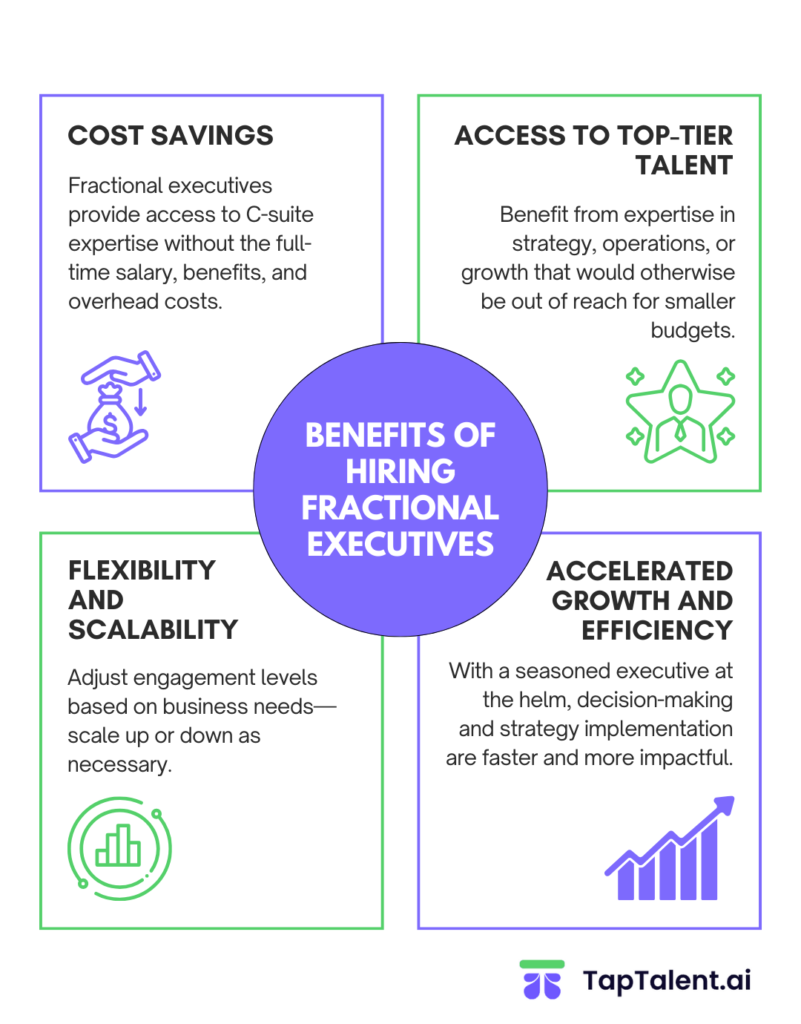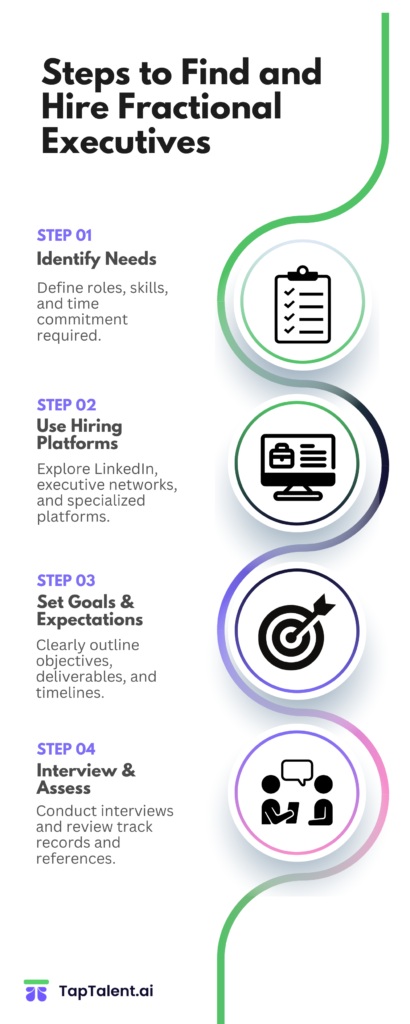Did you know that over 40% of companies plan to hire fractional executives to fill leadership gaps by 2025? This growing trend is reshaping the way businesses approach leadership, especially for startups and small-to-medium-sized enterprises (SMBs) that need top-tier talent but can’t always afford full-time executives. Fractional executives—part-time leaders offering specialized expertise on a flexible schedule—are now essential to businesses navigating budget constraints, scaling challenges, and leadership voids. From CFOs to CMOs, fractional executives bring invaluable experience for short-term projects or transitions without the long-term commitment of a full-time hire.
In this blog, we’ll explore why fractional executives are becoming an indispensable solution, how to hire and integrate them effectively, and how to future-proof your hiring strategy for this evolving talent model. Whether you’re struggling with leadership gaps or seeking cost-effective ways to scale, read on to discover how fractional executives can help you lead with flexibility and expertise.
Understanding Fractional Executives
As businesses continue to evolve in a fast-paced and cost-conscious environment, fractional executives have become a game-changing solution for companies of all sizes. But what exactly are fractional executives, and why are they gaining traction? Simply put, fractional executives are high-level professionals who provide strategic leadership on a part-time, flexible basis.
Instead of hiring a full-time executive, organizations can bring in an experienced leader to address specific needs, whether it’s overseeing a transitional period, leading key projects, or providing expertise in areas like finance, marketing, or operations.
What Are Fractional Executives?
Fractional executives typically hold senior positions such as Chief Financial Officer (CFO), Chief Marketing Officer (CMO), Chief Technology Officer (CTO), or Chief Operating Officer (COO). These executives step into a company for a set period—ranging from a few weeks to several months—offering their skills and guidance without the long-term commitment or costs associated with hiring a full-time executive. They often provide invaluable support during growth phases, corporate restructuring, or when a company lacks in-house expertise in a particular domain.
Key Benefits of Hiring Fractional Executives
-
Cost Savings: One of the most compelling reasons to hire a fractional executive is cost savings. Full-time executives command substantial salaries and benefits packages, not to mention the overhead costs of having them on the payroll. Fractional executives, on the other hand, offer high-level expertise at a fraction of the cost. For startups and SMBs operating with leaner budgets, this can be a game-changer.
-
Access to Top-Tier Talent: Small to mid-sized businesses often struggle to compete with large enterprises when it comes to attracting top-tier talent. Fractional executives, however, bring extensive experience and industry knowledge to the table, often having worked at prestigious firms or run their own businesses. This allows companies to tap into world-class leadership and strategies without committing to a permanent hire.
-
Flexibility to Scale Leadership: Whether a company is navigating a short-term project or scaling up during rapid growth, fractional executives provide the flexibility to adjust leadership resources as needed. This adaptability ensures that businesses have the right expertise at the right time, empowering them to pivot quickly and meet their goals without the long recruitment processes involved in hiring a full-time executive.
Challenges to Be Aware Of
While fractional executives offer significant benefits, it’s important to recognize some potential challenges to ensure a successful partnership:
-
Potential Lack of Integration into Company Culture: Since fractional executives aren’t permanent members of the team, they may face difficulties in fully integrating into the company culture.
-
Need for Clear Expectations and Defined Goals: Given the limited duration of their engagement, fractional executives need to work efficiently and with a clear sense of purpose. Without clearly defined goals and expectations, there’s a risk that the project or leadership initiative may lack direction.
In conclusion, fractional executives offer a compelling solution for businesses seeking flexible, high-level leadership without the cost and commitment of full-time hires. Whether you’re navigating a transitional phase, launching a new initiative, or scaling operations, fractional leadership could provide the strategic advantage your company needs to thrive. However, it’s essential to keep in mind the challenges of integrating them into your organization, and to plan carefully for clear communication and goal-setting to ensure a successful outcome.
Next, let’s explore why the demand for fractional executives is on the rise, and how market trends and changing business needs are driving this shift.

Why the Demand for Fractional Executives Is Rising
The demand for fractional executives is not just a passing trend—it’s a direct response to shifting business landscapes and evolving workforce dynamics. Companies are increasingly recognizing the value of tapping into specialized leadership without the long-term commitment of full-time hires. Let’s explore the key factors driving this surge in popularity.
Market Trends Driving the Shift
-
Post-Pandemic Focus on Lean Operations and Flexibility
The COVID-19 pandemic reshaped how businesses operate, forcing organizations to prioritize efficiency and adaptability. Fractional executives fit seamlessly into this paradigm, allowing companies to access senior-level expertise without bloated budgets or rigid commitments. Their flexibility enables businesses to pivot quickly, adapt to market demands, and thrive in uncertain times. -
Startups and SMBs Needing Affordable Expertise
Startups and small-to-medium-sized businesses often face a dilemma: they require seasoned leadership to scale and compete but lack the resources to afford full-time executives. Fractional executives bridge this gap by providing targeted expertise on a part-time basis, offering startups the strategic insight they need to grow without compromising their financial health. -
The Rise of the Gig Economy and Executive Freelancing Platforms
Platforms like Toptal, AdvisoryCloud, and Catalant have revolutionized the gig economy for executive roles. These platforms connect companies with fractional executives who bring years of experience and proven track records. As freelancing becomes increasingly normalized in the corporate world, businesses are more willing than ever to embrace fractional leadership as a viable option.
Industries Leading the Adoption
-
Technology and SaaS
In fast-evolving sectors like technology and Software as a Service (SaaS), companies require agile leadership to tackle challenges like product scaling and go-to-market strategies. Fractional CTOs and CMOs are in high demand, providing strategic guidance to navigate these critical growth stages. -
Finance
Financial expertise is essential for fundraising, mergers, and restructuring efforts. Fractional CFOs bring extensive knowledge to startups and SMBs, helping them secure capital, streamline operations, and ensure financial stability during pivotal transitions. -
Healthcare
The healthcare industry is complex, with ever-changing regulations and compliance standards. Fractional executives in this sector, such as COOs or compliance officers, help organizations navigate these intricacies, implement efficient processes, and drive innovation.
Insights From Research
Recent studies highlight a growing reliance on fractional executives to address talent shortages in traditional hiring. For example:
- Talent Shortages: Many industries face a scarcity of full-time executive talent due to increased competition and shifting workforce expectations. Fractional executives offer an immediate solution, bringing experienced leadership without the prolonged recruitment cycle.
- Success Stories: Companies like startups in fintech or e-commerce have successfully leveraged fractional CMOs to craft data-driven marketing strategies, achieving rapid growth in highly competitive markets. Similarly, interim CFOs have been instrumental in guiding businesses through funding rounds and financial turnarounds.

How to Effectively Hire and Integrate Fractional Executives
Hiring fractional executives can be a game-changer for businesses, but success depends on finding the right talent and integrating them seamlessly into your organization. This section provides a step-by-step guide to help you navigate this process effectively.
Steps to Find the Right Talent
-
Leverage Specialized Platforms
Platforms like Toptal, AdvisoryCloud, and Catalant have made it easier than ever to find top-tier fractional executives. These platforms vet candidates for expertise and track records, ensuring that you’re only choosing from the best. They also provide tools for matching your company’s specific needs with the right professional. -
Prioritize Industry-Specific Expertise
Look for candidates who bring proven success in your industry. For example, if you’re in SaaS, a fractional CMO with experience in product-led growth will provide better results than a generalist. Industry-specific knowledge ensures faster onboarding and greater impact. -
Conduct Robust Interviews
During the interview process, assess not just technical skills but also adaptability and leadership style. Fractional executives often work in high-pressure environments, so their ability to handle change and align with your company’s vision is crucial.- Ask scenario-based questions to gauge problem-solving abilities.
- Focus on communication skills, as they’ll need to collaborate across teams
Setting Clear Expectations
-
Define Goals and Deliverables
Before onboarding, outline specific goals and deliverables in the contract. Whether it’s launching a marketing campaign or restructuring financial operations, clarity ensures alignment from day one. -
Establish Timelines and Authority
Clearly define the duration of the engagement and the decision-making authority of the fractional executive. For example:- Should they approve budgets?
- Are they empowered to hire or fire team members?
-
Provide Necessary Resources
Equip them with access to essential tools, systems, and personnel. A fractional CTO, for instance, might need detailed access to tech stacks or development team briefings to hit the ground running.
Best Practices for Onboarding
-
Foster Collaboration
Create opportunities for fractional executives to build trust with existing teams. Arrange initial meetings to introduce them, clarify their role, and set expectations for collaboration.- Use team-building exercises to establish rapport.
- Assign a point of contact to streamline communication.
-
Schedule Regular Check-Ins
Periodic reviews help track progress and ensure alignment with organizational goals. These check-ins can also be a platform for the executive to share feedback or address roadblocks. -
Emphasize Communication
Integration into company culture often hinges on effective communication. Provide them with insights into your company’s mission, values, and workflows. Encourage open dialogue to create a sense of belonging, even if their role is part-time.
Preparing Your Business for a Fractional Leadership Model
Assessing Organizational Readiness for Fractional Leadership
Before diving into the fractional executive model, evaluate whether your organization is ready. Start by identifying current leadership gaps and specific needs. For instance, if your company struggles with scaling marketing efforts, a fractional CMO could provide the expertise you require. Similarly, if financial restructuring is a priority, an interim CFO might be the answer.
Next, determine the scope of the roles fractional executives will fill. Are these short-term projects, transitional periods, or long-term strategic initiatives? Clear identification of goals ensures alignment between business needs and executive capabilities.
Key Questions to Consider:
- Which leadership roles are currently underperforming or vacant?
- What specific outcomes do you expect from fractional executives?
- How will these roles impact existing teams and workflows?
By assessing readiness, you can pave the way for a seamless transition into the fractional leadership model.
Building Internal Buy-In
Introducing fractional executives may raise concerns among stakeholders and employees. To overcome skepticism, communicate the benefits clearly. Highlight cost savings, access to expertise, and flexibility as key advantages. For example, share a case study of a startup that successfully scaled its product offerings under the guidance of a fractional CTO.
Steps to Build Buy-In:
- Educate Stakeholders: Host informational sessions about the benefits of fractional leadership.
- Share Case Studies: Present success stories from industries similar to yours.
- Address Concerns Proactively: Be transparent about how fractional roles will integrate into the company.
Building trust ensures smooth adoption and collaboration between existing teams and new executives.
Future-Proofing Your Hiring Strategy
The rise of fractional executives signals a shift toward flexible leadership. To stay competitive, develop a talent acquisition model that integrates fractional roles. This approach ensures your business can adapt to changing market conditions without the overhead of full-time hires.
How to Future-Proof Your Strategy:
- Stay Informed: Monitor trends in the fractional executive market, such as platforms offering on-demand talent.
- Incorporate Flexibility: Design roles with scalability in mind, allowing for smooth transitions as business needs evolve.
- Leverage Technology: Use AI-driven platforms to match your needs with qualified executives quickly.
For example, platforms like Toptal or AdvisoryCloud allow you to access pre-vetted executives tailored to your industry, ensuring an efficient and effective hiring process.
Transitioning to a Fractional Leadership Model
Transitioning to fractional leadership requires a well-thought-out plan. Start small by hiring a fractional executive for a specific project. This approach minimizes risk while demonstrating value to your team.
Additionally, implement performance metrics to track the impact of fractional roles. Metrics such as revenue growth, team efficiency, or project completion rates can validate the decision to stakeholders.
Conclusion: Embracing the Future with Fractional Executives
The rise of fractional executives represents a transformative shift in how businesses approach leadership. By offering flexibility, access to top-tier talent, and cost-effective solutions, these part-time executives empower companies to address leadership gaps and scale effectively.
Key Takeaways:
- Flexibility: Adapt leadership to your business needs without long-term commitments.
- Expertise on Demand: Access seasoned professionals for pivotal projects.
- Cost-Effectiveness: Optimize budgets while maintaining high-quality leadership.
Now is the time to evaluate your leadership needs and explore how fractional roles can drive your business forward. Start by assessing your organization’s readiness and identifying the gaps that could benefit from flexible, high-level expertise.




